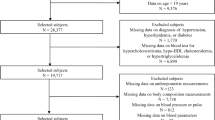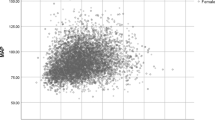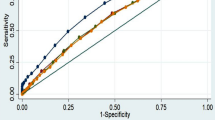Abstract
OBJECTIVE: To determine values of simple anthropometric measurements which are associated with the presence of type 2 diabetes mellitus, hypertension and dyslipidaemia and to assess anthropometric cut-off values for predicting the likelihood of these chronic conditions in a Mexican population.
DESIGN AND SETTING: The data were obtained from PRIT (Prevalence of Cardiovascular Risk Factors in General Hospital Workers) surveys from 1994 to 2000 adjusted to the structure of the overall Mexican population.
SUBJECTS: A total of 2426 men and 5939 women aged 38.99±7.11 and 39.11±14.25 y, respectively.
MEASUREMENTS: The optimal sensitivity and specificity of using various cut-off values of BMI (body mass index), WHR (waist-to-hip ratio), WC (waist circumference) and WTH (waist-to-height ratio) to predict type 2 diabetes mellitus (DM), hypertension (HT), or dyslipidaemia were examined by receiver operating characteristic curve (ROC) analysis. The likelihood ratios for having diabetes, hypertension and dyslipidaemia in subjects with various cut-off values of BMI, WHR, WC and WTH were calculated. Multiple step-wise logistic regression analysis was used to examine the independent relationship between the anthropometric indexes, age and smoking, and the odds ratio of having chronic conditions.
RESULTS: The BMI cut-off to predict DM, HT, or dyslipidaemia varied from 25.2 to 26.6 kg/m2 in both men and women. The optimal WC cut-offs were 90 cm in men and 85 cm in women. The WHR cut-off was about 0.90 in men and 0.85 in women, and the optimal WTH cut-off was 52.5 in men and varied from 53 to 53.5 in women. The cut-off levels for WC, WHR and WTH corresponded to the inflexion points in the likelihood ratio graphs. In the case of BMI likelihood ratio graphs, we found a significant increase in the risk for chronic conditions from 22 to 23 BMI levels in both genders. Logistic regression analyses disclosed that only BMI and age were included in all the models as well as the influence of smoking in DM and dyslipidaemia in men.
CONCLUSION: Although these results may not be readily applied to the rest of the Mexican population or to other Hispanic populations, they point to the necessity of similar studies with large randomized samples to find the cut-off levels for chronic conditions in different populations.
This is a preview of subscription content, access via your institution
Access options
Subscribe to this journal
Receive 12 print issues and online access
$259.00 per year
only $21.58 per issue
Buy this article
- Purchase on Springer Link
- Instant access to full article PDF
Prices may be subject to local taxes which are calculated during checkout


Similar content being viewed by others
References
Pi-Sunyer FX . Medical hazards of obesity Ann Intern Med 1993 119 (7 Pt 2): 655–660.
Higgins M, Kannel W, Garrison R, Pinsky J, Stokes J . Hazards of obesity—the Framingham experience Acta Med Scand 1988 723 (Suppl): S23–S36.
Must A, Spadano J, Coakley EH, Field AE, Colditz G, Dietz WH . The disease burden associated with overweight and obesity JAMA 1999 282: 1523–1529.
World Health Organization . Obesity. Preventing and managing the global epidemic Report of a WHO Consultation on Obesity, Geneva, 3–5 June World Health Organization: Geneva 1998
US National Institutes of Health . Clinical guidelines for the identification, evaluation, and treatment of overweight and obesity in adults National Institutes of Health: Bethesda, MD 1998
Okosun IS, Liao Y, Rotimi CN, Choi S, Cooper RS . Predictive values of waist circumference for dyslipidaemia, type 2 diabetes and hypertension in overweight White, Black, and Hispanic American adults J Clin Epidemiol 2000 53: 401–408.
Molarius A, Seidell JC, Sans S, Tuomilehto J, Kuulasmaa K . Varying sensitivity of waist action levels to identify subjects with overweight or obesity in 19 populations of the WHO MONICA Project J Clin Epidemiol 1999 52: 1213–1224.
Okosun IS, Rotimi CN, Forrester TE, Fraser H, Osotimehin B, Muna WF, Cooper RS . Predictive value of abdominal obesity cutoff points for hypertension in blacks from west African and Caribbean island nations Int J Obes Relat Metab Disord 2000 24: 180–186.
Ko GT, Chan JC, Cockram CS, Woo J . Prediction of hypertension, diabetes, dyslipidaemia or albuminuria using simple anthropometric indexes in Hong Kong Chinese Int J Obes Relat Metab Disord 1999 23: 1136–1142.
Report of the Expert Committee on the Diagnosis and Classification of Diabetes Mellitus Diabetes Care 1997 20: 1183–1197.
American Heart Association . Science advisory guide to primary prevention of cardiovascular diseases: a statement for healthcare professionals from the Task Force on Risk Reduction Circulation 1997 95: 2329–2331.
Summary of the second report of the National Cholesterol Education Program (NCEP) Expert Panel on Detection, Evaluation, and Treatment of High Blood Cholesterol in Adults (Adult treatment Panel II) JAMA 1993 269: 3015–3023.
Van der Schouw YT, Verbeek AL, Ruijs JH . ROC curves for the initial assessment of new diagnostic tests Family Pract 1992 9: 506–511.
Altman DG . Diagnostic tests. In: Altman DG, Machin D, Bryant TN, Gardner MJ (eds) Statistics with confidence 2nd edn BMJ Books: London 2000 105–119.
Han TS, van Leer EM, Seidell JC, Lean ME . Waist circumference as a screening tool for cardiovascular risk factors: evaluation of receiver operating characteristics (ROC) Obes Res 1996 4: 533–547.
Simel DL, Samsa GP, Matchar DB . Likelihood ratios with confidence: sample size estimation for diagnostic test studies J Clin Epidemiol 1991 44: 763–770.
Fanghänel-Salmón G, Sánchez-Reyes L, Arellano-Montaño S, Váldez-Liaz E, Chavira López J, Rascón-Pacheco RA . Prevalencia de factores de Riesgo de enfermedad coronoaria en trabajadores del Hospital General de México Salud Pública (Mex) 1997 39: 427–432.
Fanghänel G, Sánchez-Reyes L, Berber A, Gómez-Santos R . Evolution of the prevalence of obesity in the workers of a General Hospital in Mexico Obes Res 2001 9: 268–273.
Arroyo P, Loria A, Fernández V, Flegal KM, Kuri-Morales P, Olaiz G, Tapia-Conyer R . Prevalence of pre-obesity and obesity in urban adult Mexicans in comparison with other large surveys Obes Res 2000 8: 179–185.
Encuesta Nacional de Enfermedades Crónicas . Epidemiología SSA 1993
Flegal KM, Carroll MD, Kuczmarski RJ, Johnson CL . Overweight and obesity in the United States: prevalence and trends, 1960–1994 Int J Obes Relat Metab Disord 1998 22: 39–47.
Harris MI, Flegal KM, Cowie CC, Eberhardt MS, Goldstein DE, Little RR, Wiedmeyer HM, Byrd-Holt DD . Prevalence of diabetes, impaired fasting glucose, and impaired glucose tolerance in U.S. adults. Third National Health and Nutrition Examination Survey, 1988–1994 Diabetes Care 1998 21: 518–524.
Burt VL, Whelton P, Roccella EJ, Brown C, Cutler JA, Higgins M, Horan MJ, Labarthe D . Prevalence of hypertension in the US adult population. Results from the Third National Health and Nutrition Examination Survey, 1988–1991 Hypertension 1995 25: 305–313.
World Health Organization . The Asia-Pacific perspective: redefining obesity World Health Organization: Geneva 2000
Author information
Authors and Affiliations
Corresponding author
Rights and permissions
About this article
Cite this article
Berber, A., Gómez-Santos, R., Fanghänel, G. et al. Anthropometric indexes in the prediction of type 2 diabetes mellitus, hypertension and dyslipidaemia in a Mexican population. Int J Obes 25, 1794–1799 (2001). https://doi.org/10.1038/sj.ijo.0801827
Received:
Revised:
Accepted:
Published:
Issue Date:
DOI: https://doi.org/10.1038/sj.ijo.0801827
Keywords
This article is cited by
-
Sagittal abdominal diameter and its socioeconomic correlates: perspective of sex differences
BMC Public Health (2021)
-
Short relative leg length is associated with overweight and obesity in Mexican immigrant women
International Journal for Equity in Health (2019)
-
Influence of obesity, parental history of diabetes, and genes in type 2 diabetes: A case-control study
Scientific Reports (2019)
-
Diabetes and Impaired Fasting Glucose Prediction Using Anthropometric Indices in Adults from Maracaibo City, Venezuela
Journal of Community Health (2016)
-
Optimal waist circumference cut-off points and ability of different metabolic syndrome criteria for predicting diabetes in Japanese men and women: Japan Epidemiology Collaboration on Occupational Health Study
BMC Public Health (2016)



